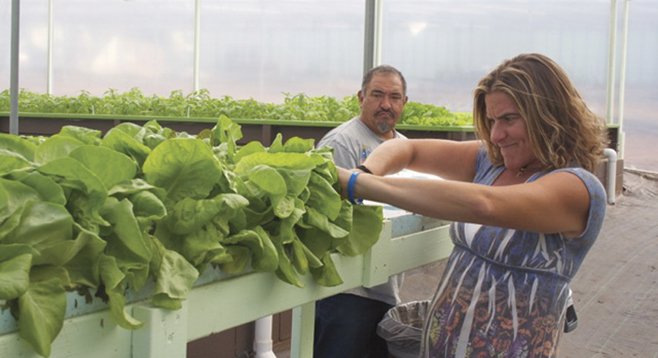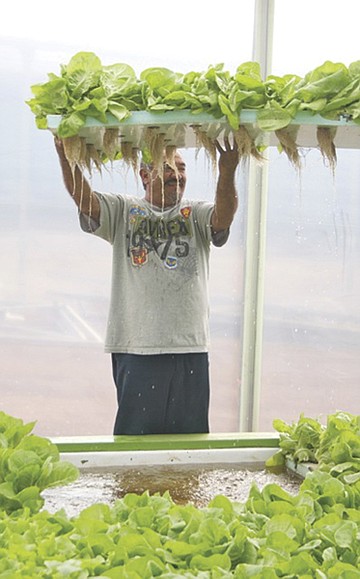 Facebook
Facebook
 X
X
 Instagram
Instagram
 TikTok
TikTok
 Youtube
Youtube

Jennifer Pankey, a formerly homeless mother of two, works five days a week inside a greenhouse tending the lettuce and basil crops at Solutions Farms, an aquaponics farm in Vista.
She works silently as she thins the bright green leaves to give them space to grow. The 8 different types of lettuce and 13 herbs flourish in the two water tanks inside a large greenhouse. The tanks are home to about 1000 tilapia fish that provide the fertilizer for the crops.
Pankey was a drug addict for 14 years before going into rehab. She’s been clean three years. When she finished her rehab stint, she turned to Solutions for Change, a Vista non-profit that helps homeless families find their way back into homes and jobs. She graduated from the program last year. Now she works at the farm and manages the organization’s apartment complex.
“I love coming to work each and every day,” Pankey said. “Tending to the vegetables is so peaceful and serene.”

Solutions for Change is run by Chris Megison and his wife Tammy. The group’s goal is to take 200 families out of homelessness within three years through the Solutions University, a 1000-day program that requires families to apply for admission and move onto the Vista campus for 500 days. There they take classes and learn skills to keep them from becoming homeless again. After the first 500 days, they move off-campus into apartments that Solutions for Change owns. They pay a maximum of $320 per month to rent a two-bedroom apartment on W. California Avenue in Vista. To pay for their rent, the residents are enrolled in an employment-training program and assigned to one of many different work assignments, the farm being one. They are also required to save 30 percent of their income in a savings account, which amounts to about $500 per month. When they graduate, they should have a minimum of $2000 in savings that can be used for new housing.
While the residents receive housing, services, and food while enrolled in the program, they are also engaged in a host of coursework and classes where they learn skills, associated mainly with work-ethic development.
Some workers are eventually employed by Solutions, while others find jobs elsewhere. The average worker at the farm is paid $10 per hour, and Megison said that more graduates of the program will be hired to work in the greenhouses in the future.
“We teach them how to get and keep a job and to develop a work ethic,” Chris Megison said.
In 2012, the total annual budget for Solutions for Change was $2.3 million.
The non-profit bought the two-acre property at 948 La Rueda for $169,000 and spent months cleaning and refurbishing with the aid of hundreds of volunteers from businesses throughout North County.
The aquaponics farm looks like something out of a science-fiction movie. Inside the 20,000 square feet of galvanized steel-and-glass greenhouses, seeds are germinated and then placed on pods of styrofoam, which are then placed into the water. A closed-loop system circulates the water beneath the styrofoam rafts of produce. Solutions Farms managers say the crops in this no-soil method use 95 percent less water than traditional farms, and the food grows three times faster.
“I couldn’t believe it, really I couldn’t,” said Cynthia Fenimore, director of social enterprise for Solutions for Change. “It’s incredible how fast this stuff grows.”
Tilapia swimming in the water fertilize the plants. The farm’s managers expect to produce about 13,000 pounds of fish the first year.
Fenimore, along with Megison, hatched the idea a year ago when they heard about a backyard aquaponics farm in Valley Center. Fenimore researched other farms and visited one in Wisconsin in winter.
“I figured if they could operate the farm year round in Wisconsin we wouldn’t have much trouble keeping it going here in Vista.”
The outlay for the first year of farm operations was about $360,000. The annual operating costs for 2013 and 2014 will be about $300,000 per year. The entire three-year operating cost is being raised from the philanthropic community and in 2013, Megison projects $150,000 revenue after all expenses, which will all be reinvested into the organization.
Megison said, “The fish can be harvested in nine months, and we’re in talks with restaurants and stores to sell direct. The money goes back into the program so that we can help more homeless families. Last month, after less than three months of growth, workers at Solutions Farms harvested its first crop of lettuce — about 600 heads of different varieties were pulled, cleaned, and sent off to some of the businesses that helped in the clean-up effort.”
Solutions’ first harvest was the week of September 3, and by October 5, workers had harvested over 10,000 plants of lettuce, bok choy, and herbs.
“When Cynthia told me about the idea of growing produce in water with fish, I didn’t see it,” Pankey said. “Thank God she knew what she was talking about and had the vision, because everything’s growing like crazy.”
Solutions farmers say they aim to produce over 39,000 plants per month by the end of 2013.
Jeffery Strauss, chef at Pamplemousse Grille in Del Mar, is in negotiations to buy Solutions Farms produce on a regular basis, and a distributor for Vista-based Frazier Farms and Whole Foods, a national chain, is looking to make some deals with Solutions. Megison is also working on becoming organically certified. “It’s about as organic as you can get,” he said, laughing. “If you add any chemicals, the fish will die and there go the crops. You have to keep the fish happy at all times.” ■


Jennifer Pankey, a formerly homeless mother of two, works five days a week inside a greenhouse tending the lettuce and basil crops at Solutions Farms, an aquaponics farm in Vista.
She works silently as she thins the bright green leaves to give them space to grow. The 8 different types of lettuce and 13 herbs flourish in the two water tanks inside a large greenhouse. The tanks are home to about 1000 tilapia fish that provide the fertilizer for the crops.
Pankey was a drug addict for 14 years before going into rehab. She’s been clean three years. When she finished her rehab stint, she turned to Solutions for Change, a Vista non-profit that helps homeless families find their way back into homes and jobs. She graduated from the program last year. Now she works at the farm and manages the organization’s apartment complex.
“I love coming to work each and every day,” Pankey said. “Tending to the vegetables is so peaceful and serene.”

Solutions for Change is run by Chris Megison and his wife Tammy. The group’s goal is to take 200 families out of homelessness within three years through the Solutions University, a 1000-day program that requires families to apply for admission and move onto the Vista campus for 500 days. There they take classes and learn skills to keep them from becoming homeless again. After the first 500 days, they move off-campus into apartments that Solutions for Change owns. They pay a maximum of $320 per month to rent a two-bedroom apartment on W. California Avenue in Vista. To pay for their rent, the residents are enrolled in an employment-training program and assigned to one of many different work assignments, the farm being one. They are also required to save 30 percent of their income in a savings account, which amounts to about $500 per month. When they graduate, they should have a minimum of $2000 in savings that can be used for new housing.
While the residents receive housing, services, and food while enrolled in the program, they are also engaged in a host of coursework and classes where they learn skills, associated mainly with work-ethic development.
Some workers are eventually employed by Solutions, while others find jobs elsewhere. The average worker at the farm is paid $10 per hour, and Megison said that more graduates of the program will be hired to work in the greenhouses in the future.
“We teach them how to get and keep a job and to develop a work ethic,” Chris Megison said.
In 2012, the total annual budget for Solutions for Change was $2.3 million.
The non-profit bought the two-acre property at 948 La Rueda for $169,000 and spent months cleaning and refurbishing with the aid of hundreds of volunteers from businesses throughout North County.
The aquaponics farm looks like something out of a science-fiction movie. Inside the 20,000 square feet of galvanized steel-and-glass greenhouses, seeds are germinated and then placed on pods of styrofoam, which are then placed into the water. A closed-loop system circulates the water beneath the styrofoam rafts of produce. Solutions Farms managers say the crops in this no-soil method use 95 percent less water than traditional farms, and the food grows three times faster.
“I couldn’t believe it, really I couldn’t,” said Cynthia Fenimore, director of social enterprise for Solutions for Change. “It’s incredible how fast this stuff grows.”
Tilapia swimming in the water fertilize the plants. The farm’s managers expect to produce about 13,000 pounds of fish the first year.
Fenimore, along with Megison, hatched the idea a year ago when they heard about a backyard aquaponics farm in Valley Center. Fenimore researched other farms and visited one in Wisconsin in winter.
“I figured if they could operate the farm year round in Wisconsin we wouldn’t have much trouble keeping it going here in Vista.”
The outlay for the first year of farm operations was about $360,000. The annual operating costs for 2013 and 2014 will be about $300,000 per year. The entire three-year operating cost is being raised from the philanthropic community and in 2013, Megison projects $150,000 revenue after all expenses, which will all be reinvested into the organization.
Megison said, “The fish can be harvested in nine months, and we’re in talks with restaurants and stores to sell direct. The money goes back into the program so that we can help more homeless families. Last month, after less than three months of growth, workers at Solutions Farms harvested its first crop of lettuce — about 600 heads of different varieties were pulled, cleaned, and sent off to some of the businesses that helped in the clean-up effort.”
Solutions’ first harvest was the week of September 3, and by October 5, workers had harvested over 10,000 plants of lettuce, bok choy, and herbs.
“When Cynthia told me about the idea of growing produce in water with fish, I didn’t see it,” Pankey said. “Thank God she knew what she was talking about and had the vision, because everything’s growing like crazy.”
Solutions farmers say they aim to produce over 39,000 plants per month by the end of 2013.
Jeffery Strauss, chef at Pamplemousse Grille in Del Mar, is in negotiations to buy Solutions Farms produce on a regular basis, and a distributor for Vista-based Frazier Farms and Whole Foods, a national chain, is looking to make some deals with Solutions. Megison is also working on becoming organically certified. “It’s about as organic as you can get,” he said, laughing. “If you add any chemicals, the fish will die and there go the crops. You have to keep the fish happy at all times.” ■
Comments